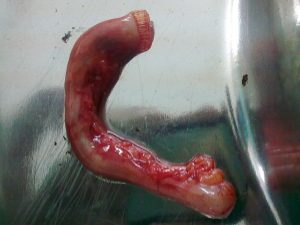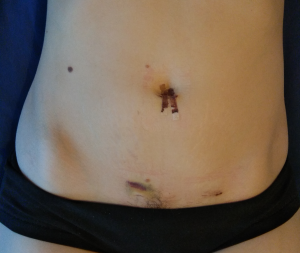Health is completely unpredictable; you never know what is waiting for you on the other end. There are moments when you feel emotionally low due to poor health. In such cases, taking pills at home does heal you. Again, some sickness wreaks havoc at times like appendicitis. The chronic pain, on the right side of the lower abdomen, can take away your sleep. Fighting those deadly hours is literally tougher. But certain signs can pre-arm yourself at once. Today the topic will solely highlight appendicitis related facts. You will primarily come to know about what are the symptoms of appendicitis and how to treat it.
Table of Contents
What is Appendicitis and what are the Symptoms?
Appendix a constricted pouch in the shape of a tube popping out from the large intestine is an inevitable portion of the gastrointestinal part. Not so important appendix, at times, can make you cry out loud. It is because infection and inflammation in the appendix can lead to blockage which causes appendicitis. Fecal substance, mucus, or parasites are the main culprit behind appendicitis.
You need to opt for immediate treatment otherwise the rupture can break the obstruction and pose threat by releasing the fatal bacteria into the abdomen. Such a scenario might cause infection which is coined as Peritonitis. Opt for medical assistance within 24 hours as delaying beyond that might turn out fatal for the patient.
Causes of appendicitis
Before heading to understand the symptoms of appendicitis, the causes need special attention to prevent it in the first place. Well, no one is sure what the exact causes of getting appendicitis are. However, we have cited some of the plausible causes illustrated so far by doctors in the pointers below:
- Infection in the gastrointestinal tract causes the tissues to swell up on the appendix wall
- The bacteria gets doubled up leading to pus deposition in the appendix
- Some kind of blockage on the appendix lining
- Inflamed bowel disease
- Parasite build up in the appendix lumen
- Abdominal trauma

Symptoms of Appendicitis
This segment will give a quick highlight of what are the symptoms of appendicitis. Though the symptoms are varied, we will focus on different categories like adults, children, and pregnant women:
Appendicitis in Adults
Check out the following points to detect the appendix symptoms in adults:
Abdominal pain
The razor-sharp pain pricking you feel on the right abdomen arising above the torso is appendicitis pain. The intensity of the pain is similar throughout, the consistent aching gives you nerve-wracking feel. For some, the pain arises from the lower back portion due to the placement of the appendix. Note in such people, the appendix is behind the colon.
Fever but mild
An inflamed appendix might let you down with fever. Generally, the mercury level reads somewhere between 99 F to 100.5 F. Rupture of the appendix followed by enhanced heartbeat might shoot up the temperature to 101 F.
Losing appetite
Food craving is normal for any person, but appendicitis might hamper that appetite’s willingness. At once you will get nausea and even develop diarrhea. Gas related problem and obstructed bowel passage is one more additional symptom.
The above penned are the possible adult-related appendicitis symptoms.
Symptoms of Appendicitis in Children
Difficult for children to differentiate the pain, often makes appendix unrecognizable to them. The sharp, acute pain arises from a single point eventually disseminates to the rest of the stomach. Indeed the little bundles are unware which is the exact troublesome area.
Worried parents might confuse the appendicitis pain with urinary tract infection or bud in the stomach. However, parents should pay heed to underline symptoms like whether the child is vomiting, having a swollen abdomen, or tenderness in the abdomen. The said are the symptoms for infants. Again, older children might have nausea, pain in the abdominal area, and more.
Appendicitis symptoms in pregnant women
Pregnancy discomforts are unpredictable and unbearable. On top of that, vomiting, feeling nausea and sudden cramping creates an additional dilemma. Across pregnancy, the enlarged uterus may lift the appendix thus causing the pain to spike up from the left side of the abdomen rather right. Gas, heartburn, missed bowels, constipation is the presumptive symptoms. Note that pregnant women may not feel the exactly penned appendicitis symptoms especially those who are heading to late pregnancy or are already into that phase.
Appendicitis test before surgery
Before the final treatment procedure, the doctor will thoroughly eye out the symptoms:
Blood test diagnosis
Once you visit the dispensary, the doctor will ask you to get the blood test report. As you get that he will scrutinize the estimation of RBC and WBC. If white blood cells are more than RBC, it’s signaling that you have got appendicitis.
Diagnosing urine
Doctors will pay equal importance to the urine test to ensure that the underlining pain is not due to kidney stones or UTI. With no such pre-hint on the report, the doctor gets confirmed that its appendicitis.
Diagnosing through imaging
At last, the doctor may ask to show the USG report to detect the underlying cause of the pain. Subsequently, it will validate whether the pain is due to appendicitis or not.
Physical detection
If required, the doctor may put pressure with hand on the appendicitis area. With the release of pressure, the tender area will ache at once.
Decoding appendicitis treatment
Before moving on to surgical eradication of appendicitis, doctors will prescribe doses of antibiotics. You need to finish on time to prepare the body to be under the knife:
Glimpse on appendectomy
To perform open appendectomy post-check-up the specialist will slit through once on the right side of the abdomen focusing on the lower part. Once pocketed the appendix, rounds of stitches are applied to conceal the operated area. Open appendectomy in a way is better as it helps the surgeons to wipe off the inflamed appendix.
Laparoscopic incision
Laparoscopic appendectomy is followed by few slits on the abdomen area. Thin, long shaped tube featuring a camera and light is placed inside the abdomen. The doctors get the interior images on the screen precisely projected. Seeing through that guided image, they do perform the operation. Eventually, stitch up the incision part and clean up the in and round operated area.

Home care post appendix treatment
Here are some of the safety measures to take care of your health after an appendix operation:
No heavy work
Putting up with open appendectomy is not a cakewalk. So, count on ample rest and try to limit your steps from engaging in any strenuous activities. In the case of laparoscopy, the limitation is for four to five days. However, in case of open appendectomy need to recommence work after 14 days.
Short movements
The moment you feel that the wound ache is not getting over you, start walking slowly and ensure to indulge in brief walks inside the room.
Be easy and sleep
With the gradual healing of the wound, the body would feel relaxed, therefore, getting sleepier often is natural. So, be ready to get adequate sleep whenever required.
Support the abdominal area
While couching or sneezing be sure to offer support to the abdominal area. Pillow can be an ideal choice as the support for the abdomen. Just place it lightly on top, and cough with relaxation.
Resuming the normal life
After the hectic surgery, the body will take time to mobilize. Prior to making outside ventures, follow post-check-up with the surgeons. A month of reclusion is enough for both adults and children.

Complications of appendix surgery
So far you have a hint on what are the symptoms of appendicitis? Now set your eyes on the post-surgery complication. To make it understandable we have segregated in points:
Get wounded
Majorly, operated patients suffer from infection in the wound area. Indeed this is the most common.
Formation of pus
The surgical area may be swollen serving as the breeding shelter for pus. Note abscess forms exactly in the area from where the appendix has been withdrawn.
Unknown danger
Not so frequent ailments may pop up just after the appendix surgery. Such as bowel gangrene, obstruction in the bowel movement, and peritonitis may create a hurdle.
Foods to take post appendix surgery to alleviate symptoms
Long back it all started, food craving almost was disappeared. Constant feeling of nausea and vomiting literally killed your likeliness for foods. So, now we will discuss some of the foods that you can diligently add to the platter post- appendix-surgery.
Start with easily digestible dishes
Post appendix surgery you have to be careful with whatever you take. Better to go with complete liquid dishes, it can be anything from soups to milk. Though enriched with calcium and protein, still the intake should be as per the doctor’s suggestion.
Back to the usual diet
It’s time to plunge to your regular diet; so try adding all sorts of nutritiously enriched foods. Follow mix and match items on the platter starting from poultry-based foods to low fat based dairy items. Ensure to add the fruits and vegetables as altogether it will speed up the healing process. Also, the foods will offer adequate energy to the body as well.
Foods to cure symptoms of Appendicitis
It’s not easy to be under a knife; though your body starts to heal due to the series of medical doses, still you need to hang on having certain balanced foods. Talking about the balanced form of the diet, it should have equal proportions of carbs, proteins, and fat. The slit portion needs to repair and for that, your body demands more of protein. Coming to protein its addition enhances the growth of connective tissue, which forms collagen; that fills the slit area in no time.
Snuggle with avocados, nuts, seeds, olive oil whenever you want to as these fat-rich foods will form fresh cells. Renewed cells largely contribute to healing the inflammation no sooner.
Only proteins and fats won’t do the whole thing, to get completely healed, have carbohydrates in a moderate amount as well. Brown rice, whole wheat, vegetable, and fruits are indispensable in terms of their goodness. Replenish the energy factory of the body along with build up more cells. Also, augment the cells count as well.
Foods to level up immunity from Appendicitis
Going through a surgery extensively means you need to rework on the immunity factors. Immunity enriched elements such as vitamin A, Vitamin E, and C have to be there uncompromisingly. Keeping these on your plate literally means you can avert the infection at once.
Why do you need to add Vitamin A? Being under a knife attack, your body is taking time to heal. To make it faster, you need to maximize the immunity count. Vitamin A will work specifically on the digestive and respiratory portions ensuring a well protective guard. You can add some generous amount of green leafy vegetables to your everyday preparation.

Unrestricted radicals are there in the body, if left unattended can detain the healing process. To bind them, have more and more of Vitamin E. However, you may think of how vitamin E turns out effective. Well, vitamin E such as red peppers has the power to shield the cells from being kicked off by those free radicals. Antibodies and immunity of cells have a direct relationship. So to bolster up the antibodies, have to have more of Vitamin C.
You can’t leave the zinc unattended as well. It has to be there always to activate the white blood cells functioning. Talking of the WBC it is the creator of antibodies, booster of immunity, and an infection healer. On the whole, its role is equally massive, as it keeps up the cohesive property of the skin intact.

